Nieves
Concostrina.
Journalist and writer
Madrid-SpainMiscellaneous
A journalist by profession, although she has also written five books, Nieves Concostrina was born in Madrid in 1961. She learnt her craft on the now-defunct Diario 16 newspaper and worked in television. Since 1997 she has been Editor-in-Chief of the Adiós magazine, a weekly publication currently published by the Spanish funeral services company FUNESPAÑA, which meant a career move into the world of death, a subject on which she speaks and writes with confidence, but also with delicacy.
She directed and presented the Polvo Eres slot on Radio 5 Todo Noticias and was involved in the weekend programme No es un día cualquiera. Likewise, she contributed to the En días como hoy programme with the anniversary of the major event of the day.
In April 2010 she won the King of Spain International Journalism Prize in the Radio category for one episode of a series of 24 entitled Acércate al Quijote. That same year, she was also awarded the Golden Microphone prize. In November 2005 she was awarded the 20th Andalusia Journalism Prize, in the Radio category. She has also received the Villa de Madrid Journalism Award and the Paradores de España International Story Award.
As a writer, she has published five books. Her work Polvo Eres, with the subtitle Peripecias y extravagancias de algunos cadáveres inquietos, which went on sale on 15 January 2008, was already into its second edition only a fortnight later and is now into its twelfth edition. Her second book, Menudas historias de la Historia, came out in April 2009 and is now into its nineteenth edition. April 2010 saw the publication of Y en polvo te convertirás, which by September had already gone into its second edition. One year later, the sequel Polvo Eres II arrived, with illustrations by the cartoonist Antonio Fraguas “Forges”. The book was republished in paperback under the title Muertes ilustradas de la Humanidad. Her latest publication, on sale since April 2012, is Se armó la de San Quintín which, like the others, is having great success and has already gone into its second edition.
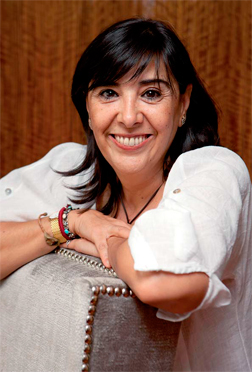


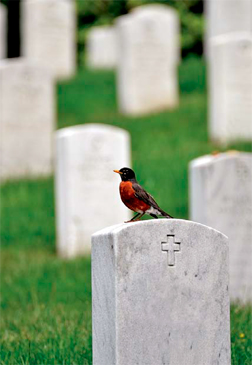

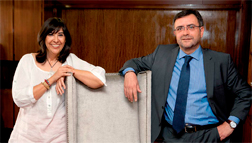
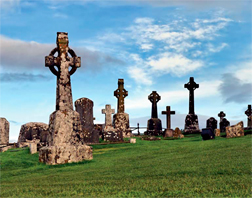
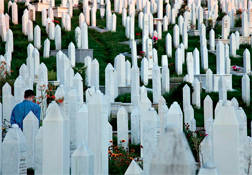

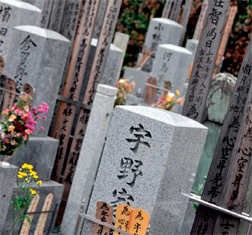
“I would have liked to ask Cervantes about that place at La Mancha”
Death makes Nieves Concostrina feel sad, so she does not waste a single minute of her time thinking about it, except professionally, because, from the Adiós magazine or her radio programmes, this journalist has spent around fifteen years telling lots of stories about dead people, cemeteries and epitaphs. Now she also confesses that she would have liked to have a good talk with Cervantes to ask, amongst other things, about that place at La Mancha.
Journalist, writer or both?
Journalist. I do not really care whether people think of me as a writer because I have published five books. My profession is journalism and what I say in the books is in fact written in a journalistic style.
Press, radio, the Internet - which is your favourite format?
There are loads of funeral information every day, although you have to know where to look and be able to read between the lines
It is a good thing that television does not appear on the list, because I would have dismissed it immediately. I prefer the press, because that is where I learnt my craft as a journalist. After 25 years in the profession, I discovered radio - or rather radio discovered me, and I love it. I do not really write for the Internet, although what I do in other media may ultimately turn up there. But I prefer the press or radio, because they respect my authorship.
Interest in death
Where does your interest in death come from?
From nowhere. From my profession. I worked for the Diario 16 newspaper, where we lived through our particular crisis, back in 1997, and then I had to look for work. Jesús Pozo was offered the job of running the Adiós magazine and said to me: “I need an editor-in-chief”. I was flabbergasted, as anyone would have been. All my life working in newspaper journalism, and then suddenly having to produce a magazine about the dead!
We gradually became focused, because the first thing we wondered was what we were going to write about, and the Pharaohs popped into our heads and it seemed that there would not be anything else. But the truth is very different. There is a lot of information. A journalist has to know a little about everything and if you have to write about dead people, you write about dead people, working rigorously as with any other subject. There is a flow of funeral information every day, although you have to know where to look and be able to read between the lines.
What phrase do you most identify with: “die living” or “live dying”?
We all have a sell-by-date, like yogurts
Neither of them. I only identify my self with living. Apart from my job, I have no interest in death. Just like anyone else, I am saddened by death. I want to enjoy and work and when the time comes, that will be all. We have a sell-by-date, like yogurts.
The other main subject of your work is history, told in an entertaining way and without subterfuge. Who do you think has more fun, the public listening to or reading your stories, or you when you are working on them?
I hope we both have fun in equal measure. The truth is that I enjoy my work a lot, and I hope that the public does too.
What is the source of your inspiration?
Purely work. Reading, reading and more reading. Everything is in books and in the daily press as well, because journalism makes history.
For every audience
And who should not miss your latest book, “Se armó la de San Quintín y otras menudas historias de la historia”?
I am not trying to take anyone’s place, but I do complain that we were not taught history properly
Nobody should. The elderly, adults or teenagers. I know that children like these stories. I do not actually write for them, but I am thrilled that they want to read and listen to my stories. My style is journalistic and to the point, and I suppose that history goes in better that way because I do not pretend to be something I am not - that is to say, a historian. The stories are very short, only to arouse curiosity, and if someone is interested then what they need to do is go to more scholarly sources. I am not trying to take anyone’s place, but I do complain that we were not taught history properly. I was deprived of it. I find it a hilarious subject, especially when they tell you the truth.
Have you had any calls from some angry history teacher?
No, on the contrary, many have congratulated me and have asked my permission to use my “stories” in class and, for example, to introduce that day’s subject, in order to gain their students’ attention. It may be that some do not like them but they have never told me so.
Please tell us which story you find most entertaining.
There are lots. But, perhaps, what I find very funny is the story of the Pope who after convening the Council of Trent and imposing celibacy he finally had four children. If you take a look at the history of celibacy, it is extremely funny.
Inconvenient corpse
There are always stories regarding the dead. And related to the living?
Spain’s history is buried in its cemeteries
There are even more. But what happens is that some people have more things happen to them when they are dead than when they were alive. For example, Eva Perón spent 26 years on the move after her death, unburied, and under a false name. Her corpse went from Buenos Aires to Milan, crossed Spanish border to France at La Jonquera in a van transporting chocolate, with Franco’s permission, and arrived in Madrid, where it spent two years in a detached house at Puerta de Hierro where Perón lived. Later, it returned to Argentina, where it was placed in a crypt, before being moved again after the coup d’état. It was a political corpse, a very inconvenient one .
Cemeteries as places of history and art
“We Spaniards have been taught to leave our dead in the cemetery and not to go and see them again until the 1st of November. We do not have a cemetery culture. But people are starting to discover that cemeteries are places full of history and art which have to be visited and looked after,” says Concostrina. In our country, we already have about twenty of them included in the European Cemeteries Route. “It is proving very hard, and Jesús Pozo and I have been involved in this, from the radio and the magazine, always emphasizing that people should visit these places other than for funerals, where everybody weeps and looks at the ground”.
For the journalist, “the cemetery is art: it tells you the history of the place and of the distinguished people who are buried there. If you visit La Almudena cemetery in Madrid, you will find [Nobel Prize winner] Ramón y Cajal; and not far away, the murderer “Jarabo”, or the mausoleums of the heroes of Cuba and the Philippines. Spain’s history is buried in its cemeteries. You can learn from them and this has been happening in various European countries. But in Spain it is proving difficult because people only tend to go to cemeteries to weep or to pray.”
Concostrina demands that local councils “make cemeteries for everyone, and if anyone wants something special, they can go to a private cemetery, as Jews do. But in some towns they only have parish cemeteries, and even today in this country a person who commits suicide can be denied burial, something unthinkable in 2012, but it has happened.”
Cremations -which up until 1964 were a mortal sin, adds Concostrina- are gaining ground, but it does not look as if they will pose any threat to cemeteries. “Many people scatter the ashes, but there are also lots who take them to cemeteries.”
Are there more “stories from History” to be told?
We only need to go back 2,000 years so as not to leave our era, and we will find that in every corner of the world, in every minute, something has happened.
Bearing in mind that you have published a book per year, have you already thought about the next one?
No, I am still promoting the last one. And certainly, in the five books that I have brought out so far, I have had the advantage of my work on the radio, which meant that the prior research and documentation work was already done; starting from scratch would have been impossible.
Breaking the taboo
Talking about death continues to be taboo for many people. What do you recommend for us to lose this fear?
There is nothing funny about death, but there are people who die with humour
Not to think about it. I do not think about death, even though I write about it and work on these subjects. If I stop and think about it, tears come into my eyes - I do not want to die. Besides, as I am convinced that there is nothing afterwards, I have no comfort; you die and that is it.
Do you think that sense of humour is necessary even to die?
It is advisable to have humour for everything, but every death is individual. Where is the humour when a father is told that his son has died or when you are told that you have only six months to live? There is nothing funny about death, but in spite of everything, there are people who die with great humour.
If death is something natural and we all have a sell-by date, why are we not brought up -or why do we not bring up our own children- to face it in this way?
Religion has monopolised this subject and cares to fill our lives with fears. It has placed a heavy cultural burden on us which we are still dragging around. And when I speak of religion, I speak of religion in general, of any religion which compels us to live in fear of death and does not teach us to live happily. Until only 200 years ago, the Inquisition was executing people in our country. The last execution took place in Valencia, in 1827.
“In times of crisis, burial insurance has always emerged stronger”
The level of burial insurance in Spain stands at 51%. Another piece of information: 63% of those dying had taken out insurance of this kind. It is therefore a very mature market.
In Spain, the custom of paying funeral costs during one’s lifetime, as a monthly or annual policy, is passed down from generation to generation, although at times parents are those who pay the premium for their sons and daughters, which is normally quite small. And what happens in times of crisis? “Well, as things are very tight, in the end your parents ask you to pay the premium and you have the choice of having your own policy or not. And finally you take it over, because how can you cancel the policy when your parents have been paying for it for all those years? Burial insurance is the one that does best in times of crisis. It is strange. There are some services that people can do without, but not this one. In times of crisis, burial insurance has always emerged stronger.”
For some time now, immigrants have become an important niche market within this line of business. According to Aparicio, the cover offered to this group follows two different approaches: “for those who consider their stay to be temporary and intend to return to their home country after a period of ‘x’ years, the covers offered are for repatriation to their place of origin and the premium is a risk premium (which is cheaper). On the other hand, those who have already put down roots in Spain and do not intend to return arrange traditional burial insurance.”
Which of the distinguished deceased you talk about would you have chosen to have a chat with?
Religion has placed a slab of culture on top of us which is still being dragged
Maybe with Lope de Vega, who was a real troublemaker. He was another one who had five women and became a priest. Apart from his wit and the works he left us, I would have liked to ask him how he organised himself to have girlfriends all over the place and how he ended up being exiled and stole everybody’s women, while at other times he wore a habit and celebrated mass. He was a restless guy.
I would also go back to the Golden Age and talk to Cervantes to find out how he managed to die penniless and had to become a priest in order to get a free burial, given the works that he left. He was a genius. And above all, I would have liked to ask him about that place at La Mancha. Worst of all is that we do not know where it is. Spain has not taken care of its dead. We have lost Lope de Vega, Cervantes and Tirso de Molina, amongst others. What a shame!
Witty epitaphs
Where does the tradition of writing on tombstones come from?
The epitaph is just a way of drawing passers-by’s attention
It has always been done. The epitaph is just a way of drawing the attention of passers-by. Romans buried their dead at the side of the Appian Way and placed epitaphs there so that travellers could continue remembering them. Some are very witty.
Insurance and funeral services
How would you rate funeral services in Spain?
Spanish funeral services are among the best in the world in terms of quality, professional treatment and embalming and body preparation techniques. The sector has made great strides in modernisation, but there are still things that need to be changed, such as offering more choice. When I go to the supermarket I have a wide choice, so why not when I go to the undertaker’s? This is a country with no official religion and we have to stop placing a cross on every coffin, because some families have a really bad time when they want a secular burial. Funeral directors need to start asking how people want the burial to be and not take it for granted.
What role does burial insurance currently play and what does it contribute to the final farewell to the loved one?
I would say the same thing, that every person should choose whether or not they want to have this kind of insurance. Yes, some burial insurances have certainly evolved considerably. They already form part of packages that include Life, Health and Personal Accident covers. They have modernised and now include other kinds of services besides the funeral. But there are still some insurance companies that are stuck in the past and ought to evolve to meet the needs and demands of their customers, because I cannot imagine making payments all my life just for a funeral.
In which Spanish cemeteries can we find the most amusing epitaphs?
El epitafio no es más que una llamada de atención a los que pasan por allí
You can find great epitaphs in any cemetery, even in the humblest. At Cistierna, in León, there is one that says: “I am dead, I will be back right away”. In a very small cemetery at Riopar, in Albacete, this famous inscription can be found: “On the day I was born, everyone laughed and I cried. I lived in such a way that when I died everyone cried and I laughed. It was the effect of marijuana.” This epitaph tells a story, because the deceased died of cancer and marijuana was a palliative treatment. He evidently died with a sense of humour. But there are many like that. In Valencia, there is one that reads: “Lie down here. That is your option. You can rest, and I can, too. Román”. All of the East coast, especially Catalonia and Valencia, has generally more wit.
Is death being sweetened by funeral parlours?
It is not being sweetened. It has more to do with likes and dislikes. The funeral parlour is a necessary place and a way of taking death out of the home. I am one of those people who defend these places, but everyone has to be allowed to experience death as they wish. Let there be funeral parlours for those who want them, and a wake at home for those who do not.
Change of image
“Funeral directors and burial insurance get lumped together and today they are still seen as stagnant sectors, and that is what gave rise to the change of image,” declares Aparicio. In his opinion, the funeral sector needs to “change what it does and adapt its services to a society that is demanding new things; we are also talking about funeral directors offering the standard product, because when you analyse the service it is the same in all cases.”
The big innovation in all of this process is the funeral parlour, which did not exist 20 years ago, but which, for Aparicio, is not being used to full advantage, “because it is a place that people come to for the comfort it represents, besides avoiding the hard image of the funeral chapel in a place that has been their lifelong home. But are we using all the possibilities that this facilities offer? No, definitely not.” In his view, the big development here will come from new technologies. “Terminals could be set up in the rooms to enable the family to receive and reply to messages of sympathy. And why not show images from the deceased’s life and remind people what he was like, the people he had around him, and the things he enjoyed? At FUNESPAÑA we have one aim: to convert funerals into farewell exercises that we can offer to our customers.”
Communication between FUNESPAÑA and the insurers is fluid, says Aparicio, “at least once a year, being daily with some. We are a source of information for them on the trends in and degree of acceptance of covers, making recommendations for adjusting the service and thereby obtaining a greater level of customer satisfaction. That communication always has to exist.”
José Vicente Aparicio.
Deputy General Manager of FUNESPAÑA.
Madrid-Spain
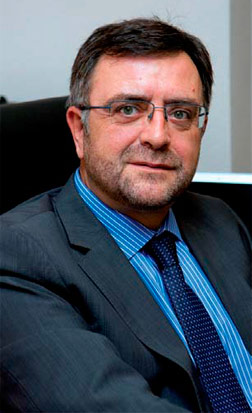
“We want to turn funerals into farewell tributes in which new technologies will play a significant role”
He was an insurance agent during the late 1970s but in the following decade José Vicente Aparicio became Head of General Insurance at FINISTERRE Insurance Company where in the 1990s he reached Marketing Director position. At the same time he was studying a Master degree in Business Management and Marketing (BMM) at ESIC Business & Marketing School. In 2001, he was appointed Technical Director of Burial Insurance at MAPFRE FINISTERRE as well as Development Manager for this burial insurance business at MAPFRE SEGUROS GENERALES and Deputy Manager of GESMAP. He currently holds the post of Deputy General Manager at FUNESPAÑA.
Burial insurance in Spain is no doubt a deeply-rooted commercial success, capable to face any crisis. Policies have become true multi-risk policies providing family assistance with wideranging benefits and other covers. But in José Vicente Aparicio’s opinion, one challenge still remains: “to turn funerals into farewell ceremonies,” a role for the funeral sector which according to the Deputy General Manager of FUNESPAÑA also needs to act as “an R&D&I department” for the market.
For Aparicio, “any professional change is enriching and broadens your view of the business. The change to the burial sector in particular demands knowledge and ongoing analysis of the different reactions of people to extreme situations. We can focus the business and new services with considerable delicacy to be able to help them, being effective without offending sensibilities. The surrounding mixture of emotions together with the objectivity required in a social atmosphere continuously changing, make the funeral business exciting and a challenge that hooks.”
The surrounding mixture of emotions and the business objectivity required, together with the continuous changes in social habits, make the funeral business exciting
Besides opening new funeral centers, FUNESPAÑA has recently acquired varioussized funeral services companies with different corporate cultures. “The increase in activity, employees, geographical locations, the heterogeneity of coexisting cultures and social developments mean that we have to redesign the business model to respond both the market and the internal organisation,” Aparicio stated.
“During the current year, we have drawn up the Strategic and Business Plan for 2012-2015 creating new structures at both central and territorial level with the new operational organisation chart. Deputy General Management key functions have been defined as follows: to comply with the Strategic Plan; consolidate the structures; drive management by objectives and coordinate the functions between the different units and areas of the company.” In addition, “the area of Business Development and R&D&I (Research and Development and Innovation), is in charge of implementing the culture of innovation, carrying out market studies, new products analysis and/or services, campaigns, branding, corporate image and quality control, amongst other things, is also directly dependent on the Deputy General Management.”
Death is undoubtedly the worst of the dramas that, sooner or later, we all have to face. In every country, culture and period of time, there are customs, rites and traditions related to death: burials and funerals, wakes at home or in funeral parlours, the cremation of the deceased and mourning. But if there is something truly Spanish, barely known elsewhere, it is burial insurance. This most traditional and popular insurance product has been sold in Spain for more than a century and it is a commercial success, as well as being deeply-rooted socially.
According to José Vicente Aparicio, burial insurance arose out as a pure economic necessity. “At the beginning of 19th century, families did not have the money to pay funerals expenses so they had to make a collection among friends, neighbours and relatives, or pay a not legally regulated agreed fee weekly, the “iguala”, to the local undertakers. From socioeconomic necessity, and with a view to guaranteeing these ‘contributions’, this insurance was created whereby, through the payment of small instalments, the insurance company undertook to pay for the burial with a total guarantee.” But they only took care of the interment and a bit more.
Evolution of the insurance
Dealing badly with grief may result in serious physical and mental consequences and that these services give guidance to families on how to put this process on the right track
Burial policies are currently giving way to burial insurance, as true multi-risk policies providing family assistance with wide-ranging benefits and other covers. The advance is unavoidable, as these policies must be adapted to families’ new habits. “Today we live very differently from the way we lived fifty years ago. People do not want to worry or rather they want to free themselves from worrying at those difficult and delicate times. In those emotional circumstances, the family is in no state, nor has any desire, to argue about prices,” adds the Deputy General Manager of FUNESPAÑA.
In his opinion, the prime advantage of such insurance “is that support from an insurance company is taken for granted. Policies prices are adjusted with the providers throughout the years so that the customer pays the right price – that is the commitment. In a way, the company defends the customer so that they get the right deal, because the service for a private individual may cost up to two or three times what it costs an insurer.”
New benefits
But it is not only about the funeral but about everything that comes ‘the day after’. “Once they have gone through the initial loss and the funeral, the relatives have to deal with lots of things; the reason for these companies to operate in this class of business. Just to mention one related to documentation processing services: changing the name on the electricity bill to channelling pensions, which is a relief,” Aparicio details.
Other benefits which have revolutionised these policies are counselling services, “because it depends on how the death occurred, who the deceased was, or how we were connected, that death might become a trauma. Dealing badly with grief may result in serious physical and mental consequences, and that these services provide guidance to families on how to put this process on the right track.”
Other covers and assistance
Along with the above features for “the day after”, new funeral expenses policies are also endorsing other covers for situations previous to the fateful moment. “Here it is a case of Health and Personal Accident products which the Insured can use during life, or for relatives to be able to receive money if the Insured dies.” These covers started to be included in the late 1970s. “Some insurers realised that it was possible to sell other types of cover, at reduce cost but on a large scale, by including other risks in burial policies.”
For Aparicio, “cash is not always available, but nowadays everyone has a credit card to pay two or three thousand euros that a funeral costs, but other issues also have to be considered, for example if the death occurs somewhere other than the place of residence. These policies also include national and international assistance or to take care of everything, regardless where the death occurs.”
This is one more example of how this insurance is evolving. “In the past it was difficult to sell these things. Because people scarcely travelled or moved, there was no need. Nor did anyone understand about psychological support, because people were generally more protected – the family was near and helped to cope with the trauma. But now, everything has changed. We are frequently far from our families because of work. People constantly travel for pleasure and also for work. This means that insurance has to evolve and adapt.”
Although being contradictory, the service provided at the moment of death is what has not actually changed much. “And that is a pending matter. The service today is the same as in the 19th century, apart from the quality of its components, but society does not think the same. This is the challenge for funeral directors. We want to turn funerals into farewell tributes in which the new technologies will play a major role.”
Distribution of the insurance
When it comes to distributing these insurances, “door-to-door” selling continues to work, notes Aparicio, highlighting the role of the premium collecting agent who visits the client each month. “His role was clear and very important. Portfolios were always updated; the agent knew who was getting married, whether they had had a child. Nowadays we have to search other alternatives because it is very difficult to find people at home at usual times. “Collection via banks,” he adds, “has led the supply systems to evolve. But there are some companies that still hire premium collectors”.
Some insurers realised that there was the possibility of selling other types of cover, at little cost but on a large scale, by including other risks in burial policies
However, other highly diversified companies “are developing synergies with other products, looking for the ‘one-stop’ customer. People come to their premises to buy insurance.” Finally, for Aparicio, online distribution is also becoming important, “although it is not tailored for burial insurance, the evolution of new technologies will boost a change in funeral services and insurance companies of this sector.”
Funeral sector
The funeral market in Spain is very fragmented. According to Aparicio, “we are talking about more than two thousand companies, the majority of which are local family businesses. There are other few operating at national level, which makes it difficult for the same service to be offered everywhere.”
In his view, the big development in this sector will be “to be offered some alternatives so that everyone can celebrate that moment as they wish, because not everyone wants the same thing. At FUNESPAÑA we are already preparing catalogues so that people may select what they want from the outset: religious or secular ceremony, cremation or burial, and other options. Through a series of questions, you are provided with an alternative and personalised service.”
Nevertheless, his view is that this sector must evolve. “We funeral directors need to become the R&D&I department of insurance companies. That must be our target, offering the customers everything that we have found they are demanding by means of market studies. It is a complete change of mentality.”
Future of this line of business
Another question is the future of this line of business and whether or not, these policies will continue to be at their peak in the coming years. “I always say that there will be people who want to be insured and others that do not. What can we do to get this 51% penetration to grow and thereby make the product more attractive? That is the obligation and the challenge for insurers; we have to reinvent ourselves. But this percentage has not changed; it is the very same as it was twenty years ago. It is our responsibility to identify the services that clients want.”
Funeral directors and burial insurance get lumped together and today they are still seen as stagnant sectors
For Aparicio, “being a mature market, these insurance products have kept on developing, although without a great innovative approach. Evolvement will come along with new rating formulas that will allow the growth of different products, so that the customer can choose the one that best suits his finances and situation. As far as the benefits under burial insurance are concerned, these will have to come from new services focusing less on burials and more on tributes and farewells, and incorporating new technologies and less standard services that are more personalised and in line with new social criteria.
Aparicio thinks that the sector is ready to respond to Solvency II requirements, “and the companies too, although there may be minimal exceptions. UNESPA (Business Association for the Insurance Sector), through its Funeral Expenses Committee, holds regular meetings with the companies in order to take care of that.”



